FROM THE SHADED REGION FIND THE INEQULAITY
To write a linear inequality in two variables, we have to understand the shaded region given. First let us see the inequality signs that we use.
|
< > ≤ ≥ |
Less than Greater than Less than or equal to Greater than or equal to |
In general after drawing the line, to fix the solution region
- Take one of the point above the line and check if the point satisfies the inequality. If it is so, we can fix the region above the line is the solution region.
If it doesn't work
- Take one of the point below the line and check if the point satisfies the inequality. If it is so, we can fix the region below the line is the solution region.
- Now we will work in backwards.
For each region below,
i) Find the equation of the line which forms the boundary and
ii) Find the inequality represented by the region.
Problem 1 :
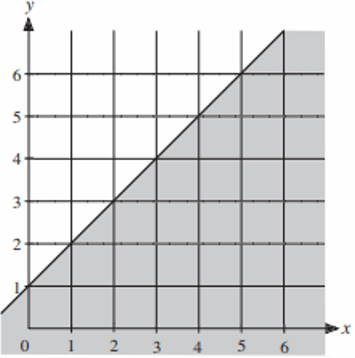
Solution :
The given is solid line. So, when we represent it as inequality, we have to use any one of the signs ≤ or ≥.
i) Slope = rise/run = 1
y-intercept = 1
So, equation of the boundary will be y = 1x + 1
ii) Selecting one of the point from the shaded region, say (2, 2) and applying in the equation above, we get
2 ___ 2 + 1
2 ___ 3
To make it as true, we have to use the sign ≤. So, the required inequality represented by the shaded region will be
y ≤ 1x + 1
Problem 2 :
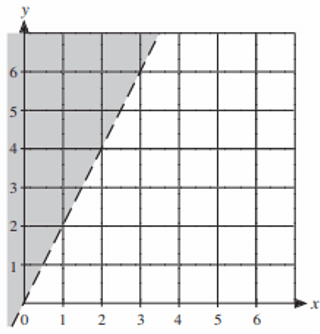
Solution :
The given is dotted line. So, when we represent it as inequality, we have to use any one of the signs < or >.
i) Slope = rise/run = 2/1
y-intercept = 0
So, equation of the boundary will be y = 2x + 0
ii) Selecting one of the point from the shaded region, say (2, 3) and applying in the equation above, we get
3 ___ 2(1)
3 __ 2
To make it as true, we have to use the sign >. So, the required inequality represented by the shaded region will be
y > 2x
Problem 3 :
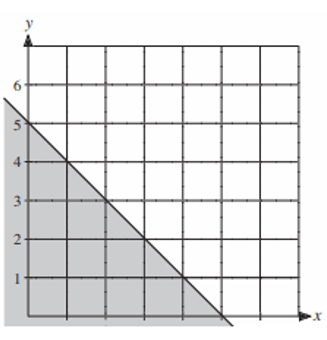
Solution :
The given is solid line. So, when we represent it as inequality, we have to use any one of the signs ≤ or ≥.
i) Slope = rise/run = -1/1
y-intercept = 5
So, equation of the boundary will be y = -1x + 5
ii) Selecting one of the point from the shaded region, say (1, 3) and applying in the equation above, we get
3 ___ -1 + 5
3 ___ 4
To make it as true, we have to use the sign ≤. So, the required inequality represented by the shaded region will be
y ≤ -1x + 5
Problem 4 :
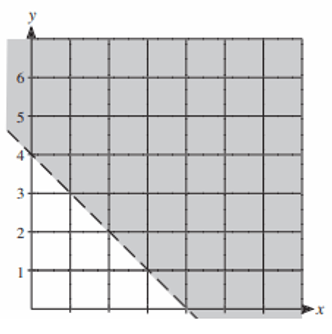
Solution :
The given is dotted line. So, when we represent it as inequality, we have to use any one of the signs < or >.
i) Slope = rise/run = -1/1
y-intercept = 4
So, equation of the boundary will be y = -1x + 4
ii) Selecting one of the point from the shaded region, say (3, 2) and applying in the equation above, we get
2 ___ -1(3) + 4
2 ___ -3 + 4
2 ___ 1
To make it as true, we have to use the sign ≤. So, the required inequality represented by the shaded region will be
y ≥ -1x + 4
Problem 5 :
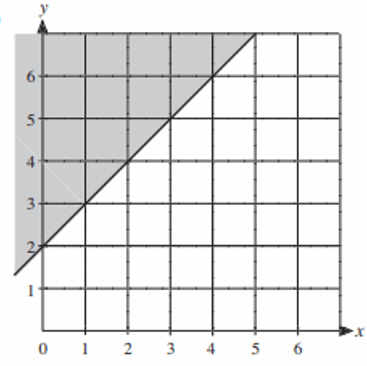
Solution :
The given is solid line. So, when we represent it as inequality, we have to use any one of the signs ≤ or ≥.
i) Slope = rise/run = 1/1
y-intercept = 2
So, equation of the boundary will be y = x + 2
ii) Selecting one of the point from the shaded region, say (1, 4) and applying in the equation above, we get
4 ___ 1 + 2
4 ___ 3
To make it as true, we have to use the sign ≥. So, the required inequality represented by the shaded region will be
y ≥ x + 2
Problem 6 :
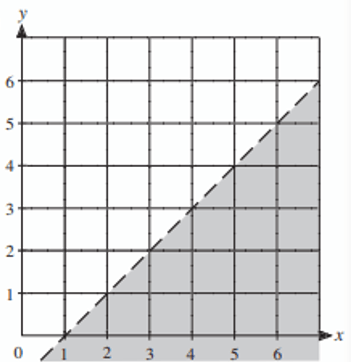
Solution :
The given is solid line. So, when we represent it as inequality, we have to use any one of the signs < or >.
i) Slope = rise/run = 1/1
Since we don't see y-intercept, we have to use point slope form to find equation of the line.
(2, 1) is one of the point of the line.
(y - y1) = m (x - x1)
(y - 1) = 1(x - 2)
y - 1 = x - 2
y = x - 2 + 1
y = x - 1
Selecting one of the points from the shades region say (4, 2).
2 ___ 4 - 1
2 ___ 3
To make it as true, we have to use the sign <. So, the required inequality
y < x - 1
Recent Articles
-
Finding Range of Values Inequality Problems
May 21, 24 08:51 PM
Finding Range of Values Inequality Problems -
Solving Two Step Inequality Word Problems
May 21, 24 08:51 AM
Solving Two Step Inequality Word Problems -
Exponential Function Context and Data Modeling
May 20, 24 10:45 PM
Exponential Function Context and Data Modeling